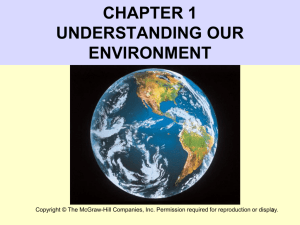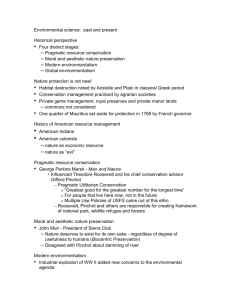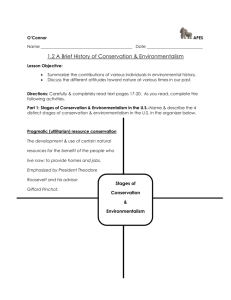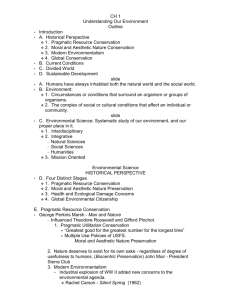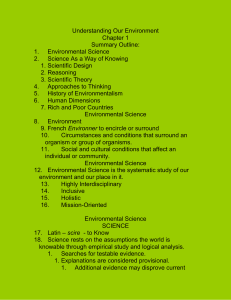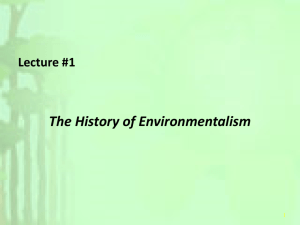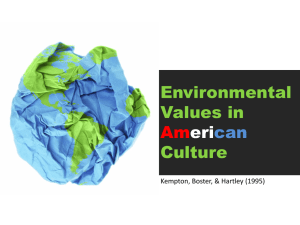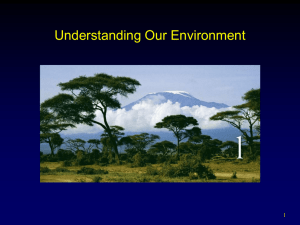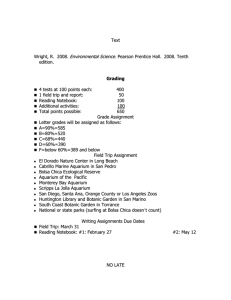Document
advertisement
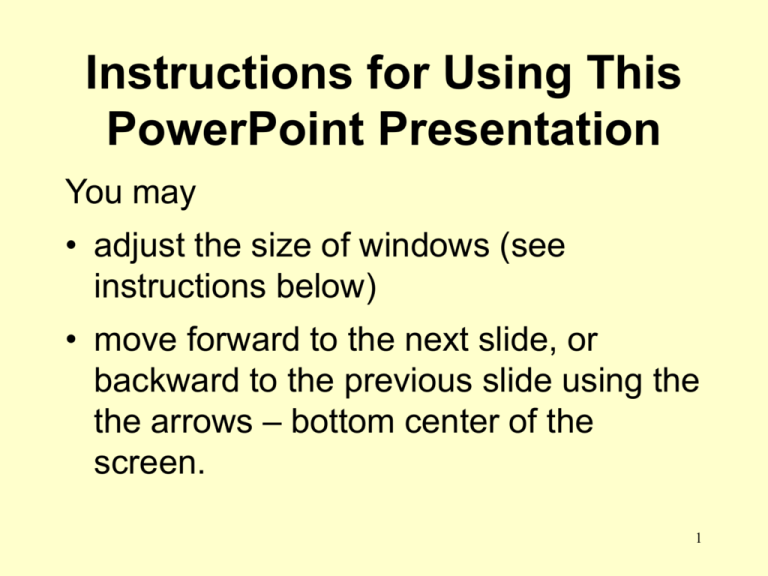
Instructions for Using This PowerPoint Presentation You may • adjust the size of windows (see instructions below) • move forward to the next slide, or backward to the previous slide using the the arrows – bottom center of the screen. 1 Chapter One: Understanding our Environment Principles of Environmental Science - Inquiry and Applications 2nd ed. 2004 by William and Mary Ann Cunningham 2 Chapter One Readings Required Reading Cunningham & Cunningham, Chapter One: Understanding Our Environment 3 Chapter One Objectives • define the term environment and identify some important environmental concerns that we face today • explain the scientific method and why it refutes or supports theories, but never proves them beyond any doubt • apply the scientific method to problem solving • explain how statistics can help evaluate the accuracy and significance of results • summarize four stages in the history of conservation • distinguish among analytical, creative, logical, critical, and reflective thinking • summarize some major environmental dilemmas and issues that shape our current environmental agenda • discuss the implications of sustainability and sustainable development 4 Chapter One Key Terms McGraw-Hill Course Glossary analytical thinking biocentric preservation blind experiments controlled studies creative thinking critical thinking deductive reasoning double-blind design environment environmental science global environmentalism hypothesis inductive reasoning logical thinking mean modern environmentalism paradigms parsimony probability reflective thinking reproducibility sample scientific theory significant numbers statistics sustainability sustainable development utilitarian conservation 5 Chapter 1 - Topics • • • • • Understanding Our Environment Science as a Way of Knowing Investigating our Environment Thinking About Thinking A Brief History of Conservation & Environmentalism • Current Environmental Conditions • Human Dimensions of environmental science 6 Part 1: Understanding Our Environment The Planet Earth • Unique in the universe (?) • Mild, relatively constant temperatures • Biogeochemical cycles • Millions of species • Diverse, self-sustaining communities 7 Environmental Science Environment is the circumstances and conditions that surround an organism or a group of organisms. Environmental science is the systematic study of our environment and our place in it. Ecology is the study of an organism or organisms, the impact of the environment on them, and their impact on the environment. 8 9 Part 2: Science as a Way of Knowing • Modern science has its roots in antiquity • Greek philosophers • Arabic mathematicians and astronomers • Chinese naturalists 10 Scientific Investigation • Deductive vs. inductive reasoning • Hypothesis - a conditional explanation that can be verified or falsified • Scientific theory an explanation that is supported by an overwhelming body of data and experience 11 Models and Natural Experiments Models • Simulate real environmental systems; • Can be physical or mathematical; • Provide heuristic information (suggestions of how things MIGHT be); and • Are influenced by researchers' assumptions. Natural Experiments • Gathering of historic evidence; and • Conducted by scientists who can't test their hypotheses directly. 12 Open Minds are Learning Minds • In some ways, children are the “ultimate” practical scientists…no pre-conceived bias in their investigations. • However, Society uses numbers, called “statistics” to let you evaluate and compare things. Information known by one person isn’t useful to Society. 13 Scientific Design • Blind Experiment – Conducted so investigators do not know which is the control and which is the experimental group, until after data have been gathered and analyzed. • Double-Blind – Neither the subject nor the investigators know which participants are receiving an experimental treatment. 14 Statistics and Probability Quantitative data • Precise and easily compared; and • Good benchmarks for measuring change. Probability • Measure of how likely something is; and • High degree of scientific certainty: 95% probability. Statistics • Important tool in both planning and evaluating scientific studies; and • Sample size, number of replications important. 15 Paradigms and Scientific Consensus Paradigms • Overarching models of the world that guide our interpretation of events • Examples: tectonic plate movement, Einstein's theory of relativity Paradigm shift • Occurs when a majority of scientists accept that the old explanation no longer explains new observations very well • Paradigm shifts are sometimes contentious and political. 16 Part 3: Thinking About Thinking 17 Table 1.3 Steps in Critical Thinking 18 Applying Critical Thinking • Identify and evaluate premises and conclusions in an argument; • Acknowledge and clarify uncertainties, vagueness, equivocation, and contradictions; • Distinguish between facts and values; • Recognize and assess assumptions; • Distinguish source reliability or unreliability; and • Recognize and understand conceptual frameworks. 19 Steps in Critical Thinking • Identify and evaluate premises and conclusions in an argument. • Acknowledge and clarify uncertainties, vagueness, equivocation, and contradictions. • Distinguish between facts and values. • Recognize and assess assumptions. • Distinguish source reliability or unreliability. • Recognize and understand conceptual frameworks. 20 Part 4. History of Conservation and Environmentalism Four Distinct Stages: – Pragmatic Resource Conservation – Moral and Aesthetic Nature Preservation – Modern Environmentalism – Global Environmental Citizenship 21 Pragmatic Resource Conservation President Theodore Roosevelt and his chief conservation advisor, Gifford Pinchot, believed in utilitarian conservation. – Forests should be saved so they can be used to provide homes and jobs. – Should be used for “the greatest good for the greatest number, for the longest time.” 22 Moral and Aesthetic Nature Preservation John Muir, first president of the Sierra Club, opposed Pinchot’s utilitarian policies. – Biocentric Preservation – emphasizes the fundamental right of all organisms to pursue their own interests 23 Modern Environmentalism Rachel Carson’s Silent Spring (1962) started the modern environmental movement. – awakened the public to threats of pollution and toxic chemicals to humans as well as other species – modern environmentalism extends concerns to include both natural resources and environmental pollution. 24 Global Concerns Increased travel and communication enables people to know about daily events in places unknown in previous generations. Global environmentalism is the recognition that we share one environment that is common to all humans. 25 Part 5: Current Environmental Conditions • Half the world's wetlands were lost in the last 100 years. • Land conversion and logging have shrunk the world's forests by as much as 50%. • Nearly three-quarters of the world's major marine fish stocks are over-fished or are being harvested beyond a sustainable rate. • Soil degradation has affected two-thirds of the world's agricultural lands in the last 50 years. 26 Major Causes of Environmental Degradation (1) Population Growth • More than 6 billion people now occupy the earth, and we are adding about 85 million more each year. • In the next decade, most population growth will be in the poorer countries - countries where present populations already strain resources and services 27 Major Causes of Environmental Degradation (cont’d) (2) Resource Extraction and Use • burning of fossil fuels • destruction of tropical rainforests and other biologically rich landscapes • production of toxic wastes 28 Major Causes of Environmental Degradation (cont’d): Acid Deposition 29 Part 6: Human Dimensions of Environmental Science • More than 1.3 billion people live in acute poverty, with an income of less than $1 (US) per day. These people generally lack access to an adequate diet, decent housing, basic sanitation, clean water, education, medical care, and other essentials. • Four out of five people in the world live in what would be considered poverty in industrialized countries. • The world's poorest people are often forced to meet short-term survival needs at the cost of long-term sustainability. 30 31 The American Lifestyle To get an average American through the day takes about 1,000 pounds of raw materials, including • 40 pounds of fossil fuels • 22 pounds of wood and paper • 119 gallons of water. Every year, Americans throw away some 160 million tons of garbage, including • 50 million tons of paper • 67 billion cans and bottles • 18 billion disposable diapers. 32 If everyone in the world tried to live at consumption levels approaching ours, the results would be disastrous. 33 Sustainability Sustainable development: progress in human well-being that we can extend or prolong over many generations, rather than just a few years. How can the nations of the world produce the goods and services needed to improve life for everyone without overtaxing the environmental systems and natural resources on which we all depend? To be truly enduring, the benefits of sustainable development must be available to all humans, not just to the members of a privileged group. 34 Indigenous Peoples Indigenous peoples are generally among the least powerful, most neglected groups. – In many countries, traditional caste systems, discriminatory laws, economics, or prejudices repress indigenous peoples. – In many places, indigenous people in traditional homelands guard undisturbed habitats and rare species. – Recognizing native land rights may safeguard ecological processes. 35 Summary: • Environmental Science • Science As a Way of Knowing – Scientific Design – Reasoning – Scientific Theory • Approaches to Thinking • History of Environmentalism • Human Dimensions – Rich and Poor Countries 36 37 Test Your Understanding Review of lesson objectives: After mastering the material in this lesson, you should be able to • define the term “environment” and identify some important environmental concerns that we face today • explain the scientific method and why it refutes or supports theories, but never proves them beyond any doubt • apply the scientific method to problem solving • explain how statistics can help evaluate the accuracy and significance of results • summarize four stages in the history of conservation • distinguish among analytical, creative, logical, critical, and reflective thinking • summarize some major environmental dilemmas and issues that shape our current environmental agenda • discuss the implications of sustainability and sustainable development 38 39
